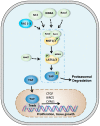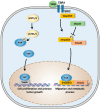Hippo/YAP Signaling Pathway: A Promising Therapeutic Target in Bone Paediatric Cancers?
- PMID: 32164350
- PMCID: PMC7139637
- DOI: 10.3390/cancers12030645
Hippo/YAP Signaling Pathway: A Promising Therapeutic Target in Bone Paediatric Cancers?
Abstract
Osteosarcoma and Ewing sarcoma are the most prevalent bone pediatric tumors. Despite intensive basic and medical research studies to discover new therapeutics and to improve current treatments, almost 40% of osteosarcoma and Ewing sarcoma patients succumb to the disease. Patients with poor prognosis are related to either the presence of metastases at diagnosis or resistance to chemotherapy. Over the past ten years, considerable interest for the Hippo/YAP signaling pathway has taken place within the cancer research community. This signaling pathway operates at different steps of tumor progression: Primary tumor growth, angiogenesis, epithelial to mesenchymal transition, and metastatic dissemination. This review discusses the current knowledge about the involvement of the Hippo signaling pathway in cancer and specifically in paediatric bone sarcoma progression.
Keywords: Ewing sarcoma; YAP; hippo signaling pathway; osteosarcoma.
Conflict of interest statement
The authors declare no conflict of interest.
Figures




References
-
- Xu T., Wang W., Zhang S., Stewart R.A., Yu W. Identifying tumor suppressors in genetic mosaics: The Drosophila lats gene encodes a putative protein kinase. Development. 1995;121:1053–1063. - PubMed
Publication types
LinkOut - more resources
Full Text Sources
Miscellaneous

